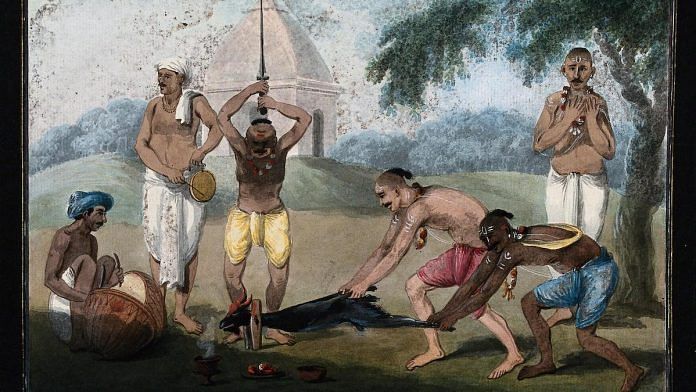In 2020, the National Museum in New Delhi made headlines by opposing meat from a carefully-researched menu recreating the cuisine of the Harappan civilisation of nearly 4,500 years ago. This decision was, according to the museum’s additional director, a sentimental one based on a long-standing policy of not serving meat at the National Museum, which appears to have been established after protests by fundamentalists in 2002.
The National Museum’s decision is indicative of how we think about food in India today, with restrictions on the sale or consumption of meat becoming commonplace. Despite repeated studies showing that meat-eating is fairly universal across the subcontinent, the notion that India “should be”, or originally “was”, a vegetarian land is continuously repeated. Vegetarianism is associated with ideas of purity and often tied to the status of a community; dietary restrictions and fasting are associated with ritual significance, as continued annual fasts by millions on occasions such as Akshaya Tritiya show. But where did these notions come from, and why? Like with many things in modern India, the answer lies in our medieval past.
Beef-eating Brahmins and fat Buddhists
“She eats grass only from land duly appointed for grazing, all the people who eat in this wide land… she nourishes with sweet, excellent milk. She has a generous heart. Why do you hold such hatred for her? Tell me what you are thinking, priests learned in the ancient Veda,” proclaims Aputtiran, one of the protagonists of the Manimegalai, the great Tamil Buddhist epic dated to the sixth century CE. His audience is a group of Vedic priests who are about to sacrifice a cow, because, according to the Manimegalai, their “goal is meat”. This episode, from Canto 13 of the epic, is surprising. Though we stereotypically think of Hindu priests avoiding meat at all costs, it appears that in early medieval Tamil Nadu, it was Buddhists who were most insistent on avoiding it.
As we read the Manimegalai in conjunction with other evidence, though, our picture changes. In Food Fights: Buddhist, Hindu and Jain Dietary Polemics in South India, historian Katherine Ulrich shows that the Manimegalai was being rather disingenuous in its presentation of Buddhist dietary habits. In the Matta-Vilasa Prahasana or “The Farce of the Drunkard’s Games”, a play by the 7th century Pallava king Mahendravarman I, Buddhists are thoroughly lambasted for being greedy for meat and fish. Indeed, the protagonist of the play, a Shaivite ascetic who has lost his skull begging-bowl, is convinced that only a Buddhist or a dog could have stolen it because it had meat in it.
Jains were also a significant religious force in medieval Tamil Nadu, and we would certainly expect that, like modern Jains, they were strictly vegetarian. That is until we read the poems of the 8th century Shaiva saint Campantar, nearly 10 per cent of whose work is dedicated to vitriolic criticism of Buddhists and Jains. Jains, according to Campantar, secretly “desire fish cooked with meat”, though they piously claim to subsist mostly on gruel and nuts. Evidently, accusing your rivals of eating meat had great significance for medieval religious leaders.
Also read: Indian history without the Deccan is like European history minus France
The reality of medieval diets
To see medieval India as a world only of religious screeds is obviously simplistic. What, then, do other sources tell us about food? A somewhat later text, the Manasollasa of the Chalukya king Someshvara III (1127–1138 CE) provides us a totally unexpected picture. Indeed, rather than avoiding or dismissing meat, it is portrayed as one of the most crucial aspects of bhoga — the king’s enjoyment of the luxuries of his court. Among the over 100 meat dishes it describes include such oddities as blood sausages, goat heads, barbecued river rats, and grilled stomach membrane. Game birds, venison, and pork are considered delicacies, richly spiced with asafoetida, ginger, turmeric, pepper, mustard, coriander, and cumin. Meat was cooked on skewers, curried, grilled, fried in ghee; recipes similar to kebabs are presented centuries before the advent of any Muslim-ruled polities. Indeed, per the Manasollasa, meat was to be eaten through at least three of the five-course meals it prescribes for kings!
All this suggests that in the medieval period, meat was being eaten by most (whether openly or secretively), irrespective of religion. So, why were religious leaders all criticising others for doing so? According to historian Katherine Ulrich, we need to read these polemics within their socio-economic context. The medieval period was a time of much tumult. With the emergence of new military and social elites and state structures, much more money was suddenly available as donations to religious sects. In order to attract patronage, these sects all needed to establish their distinctiveness and ritual efficacy. One of the best ways to do so, it seems, was to use dietary restrictions and “purity” as a way to prove their superiority over other groups. Of course, despite the fulminations of preachers, it seems that in practice medieval people continued to follow their tastebuds.
It’s worth asking how much has really changed in terms of how religious sects present themselves in India. Or perhaps what we should dwell upon is how different our response to religious claims is from those of our medieval ancestors — and why fundamentalist strategies over a thousand years old still seem to cast their shadow over a modern nation-state.
Anirudh Kanisetti is a public historian. He is the author of Lords of the Deccan, a new history of medieval South India, and hosts the Echoes of India and Yuddha podcasts. He tweets @AKanisetti. Views are personal.
This article is a part of the ‘Thinking Medieval‘ series that takes a deep dive into India’s medieval culture, politics, and history.
(Edited by Neera Majumdar)



